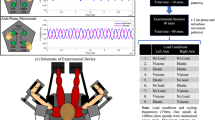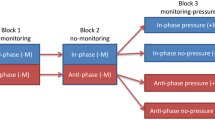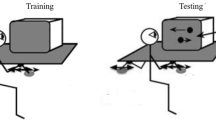Abstract
The stability of bimanual performance of the frequency ratios 3∶8 and 5∶8 was examined from the perspective of the sine circle map and the associated Farey mode-locking hierarchy. By gradually increasing movement frequency, abrupt transitions from the initial frequency ratios to other frequency ratios were induced. In general, transitions occurred to frequency ratios that were near the initial frequency ratio but lower in the Farey ordering and, hence, of higher stability in the sine circle map. A fair percentage of these transitions were to unimodularly related ratios. The transition routes from 3∶8 and 5∶8 remained largely unaffected by extensive practice of the lower-order ratios 2∶5 and 3∶5. Collectively, these results suggest that (i) bimanual tapping occurs in a domain in which frequency-locked states either overlap or are located sufficiently close to each other to make stochastic switching possible (coupling parameter K > 1 or close to 1); (ii) the overall stability of these frequency-locked states decreases as movement frequency increases (due to a decrease in K) and, consequently, (iii) the probability of transitions to nearby frequency ratios increases as movement frequency increases, due to the differential stability of the frequency locks.
Similar content being viewed by others
References
Allen T (1983) On the arithmetic of phase-locking: coupled neurons as a lattice on R2. Physica 6D:305–320
Ayoub R (1963) An introduction to the analytic theory of numbers. American Mathematical Society, Providence
Beek PJ, Peper CE, Wieringen PCW van (1992) Frequency locking, frequency modulation, and bifurcations in dynamic movement systems. In: Stelmach GE, Requin J (eds) Tutorials in motor behavior. II. North-Holland, Amsterdam, pp 599–622
Beek PJ, Turvey MT (1992) Temporal patterning in cascade juggling. J Exp Psychol Hum Percept Perform 18:934–947
Belykh VN, Pedersen NF, Soerensen OH (1977) Shunted-Josephson-junction model. II. The nonautonomous case. Phys Rev B 16:4860–4871
Bramble DM, Carrier DR (1983) Running and breathing in mammals. Science 219:251–256
Crowley MF, Field JF (1986) Electrically coupled Belousov-Zhabotinskii oscillators. 1. Experiments and simulations. J Phys Chem 90:1907–1915
Cvitanović P, Shraiman B, Söderberg B (1985) Scaling laws of mode lockings in circle maps. Phys Scr 32:263–270
deGuzman CG, Kelso JAS (1991) Multifrequency behavioral patterns and the phase attractive circle map. Biol Cybern 64:485–495
Deutsch D (1983) The generation of two isochronous sequences in parallel. Percept Psychophys 34:331–337
Epstein IR (1990) Chemical oscillators and nonlinear chemical dynamics. In: Jen E (eds) 1989 Lectures in complex systems, SFI studies in the sciences of complexity, Lect Vol II. Addison-Wesley, Reading pp 213–269
González DL, Piro O (1985) Symmetric kicked self-oscillators: iterated maps, strange attractors, and symmetry of the phase locking Farey hierarchy. Phys Rev Lett 55:17–20
Guevara MR, Glass L (1982) Phase locking, period doubling, bifurcations and chaos in a mathematical model of a periodically driven oscillator: a theory for the entrainment of biological oscillators and the generation of cardiac dysrhythmias. J Theor Biol 14:1–23
Haken H, Kelso JAS, Bunz H (1985) A theortical model of phase transitions in human hand movements. Biol Cybern 51:347–356
Hardy GH, Wright EM (1965) An introduction to the theory of numbers. Clarendon Press, Oxford
Hilborn RC (1994) Chaos and nonlinear dynamics: an introduction for scientists and engineers. University Press, Oxford
Jackson EA (1989) Perspectives of nonlinear dynamics, Vol I. Cambridge University Press, Cambridge, UK
Jagacinski RJ, Marshburn E, Klapp ST, Jones MR (1988) Test of parallel versus integrated structure in polyrhyhmic tapping. J Motor Behav 20:416–422
Jensen MH, Bak P, Bohr T (1984) Transition to chaos by interaction of resonances in dissipative systems. I. Circle maps. Phys Rev A 30:1960–1969
Kelso JAS (1981) On the oscillatory basis of movement. Bull Psychon Soc 18:63
Kelso JAS (1984) Phase transitions and critical behavior in human bimanual coordination. Am J Physiol Reg Integr Comp Physiol 15:R1000-R1004
Kelso JAS, deGuzman GC (1988) Order in time: how the cooperation between the hands informs the design of the brain. In: Haken H (eds) Neural synergetic computers. Springer, Berlin Heidelberg New York, pp 180–196
Kelso JAS, deGuzman GC, Holroyd T (1990) The self-organized phase attractive dynamics of coordination. In: Babloyantz A (eds) Self-organization, emerging properties and learning. Plenum Press, New York, pp 41–62
Marek M, Stulch I (1975) Synchronization in two interacting oscillatory systems. Biophys Chem 3:241–248
Maselko J, Swinney HL (1985) A complex transition sequence in the Belousov-Zhabotinskii reaction. Phys Scr T9:35–39
Miller NR, Shapiro R, McLaughlin TM (1980) A technique for obtaining spatial kinematic parameters of segments of biomechanical systems for cinematographic data. J Biomech 13:535–547
Moe GK, Jalife J, Mueller WJ, Moe B (1977) A mathematical model of parasystole and its application to clinical arrhythmias. Circulation 56:968–979
Peper CE, Beek PJ, Wieringen PCW van (1991) Bifurcations in bimanual tapping: in search of Farey principles. In: Requin J, Stelmach GE (eds) Tutorials in motor neuroscience. Kluwer, Dordrecht, pp 413–431
Peper CE, Beek PJ, Wieringen PCW van (1995) Multifrequency coordination in bimanual tapping: asymmetrical coupling and signs of supercritically. J Exp Psychol Hum Percept Perform, in press
Perkel DH, Schulman JH, Bullock TH, Moore CP, Segundo JP (1964) Pacemaker neurons: effects of regularly spaced synaptic input. Science 145:61–63
Schöner G, Kelso JAS (1988a) A synergetic theory of environmentally-specified and learned patterns of movement coordination. I. Relative phase dynamics. Biol Cybern 58:71–80
Schöner G, Kelso JAS (1988b) A synergetic theory of environmentally-specified and learned patterns of movement coordination. II. Component oscillator dynamics. Biol Cybern 58:81–89
Shapiro R (1978) Direct linear transformation method for three-dimensional cinematography. Res Q 49:197–205
Sternad D, Turvey MT, Schmidt RC (1992) Average phase difference theory and 1∶1 entrainment in interlimb coordination. Biol Cybern 67:223–231
Summers JJ, Rosenbaum DA, Burns BD, Ford S (1993) Production of polyrhythms. J Exp Psychol Hum Percept Perform 19:416–428
Treffner PJ, Turvey MT (1993) Resonance constraints on rhythmic movement. J Exp Psychol Hum Percept Perform 19:1221–1237
Winfree AT (1980) The geometry of biological time. Springer, Berlin Heidelberg New York
Zanone PG, Kelso JAS (1992) The evolution of behavioral attractors with learning: nonequilibrium phase transitions. J Exp Psychol Hum Percept Perform 18:403–421
Author information
Authors and Affiliations
Rights and permissions
About this article
Cite this article
Peper, C.(.E., Beek, P.J. & van Wieringen, P.C.W. Frequency-induced phase transitions in bimanual tapping. Biol. Cybern. 73, 301–309 (1995). https://doi.org/10.1007/BF00199466
Received:
Accepted:
Issue Date:
DOI: https://doi.org/10.1007/BF00199466




